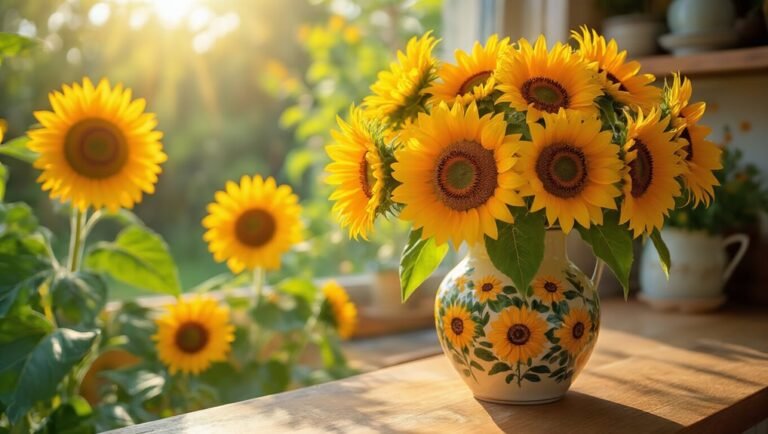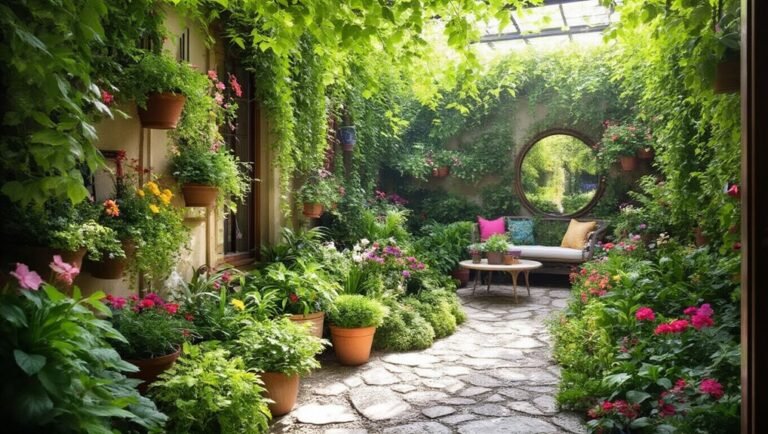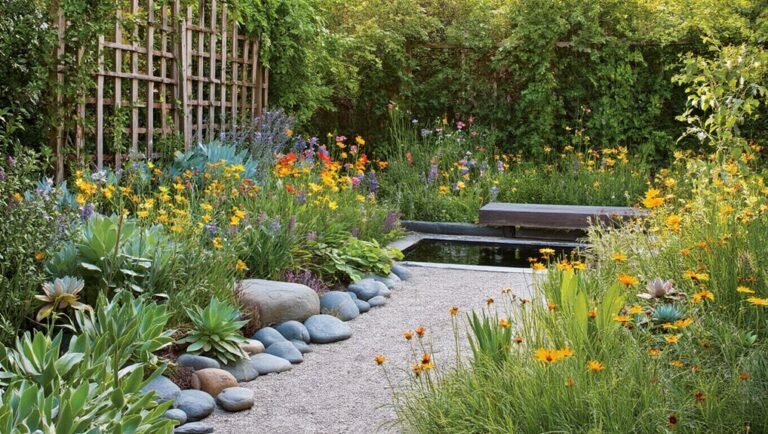The #1 secret to professional garden design is the focal point. It transforms your garden from ordinary to extraordinary, drawing the eye and guiding exploration. Whether it’s a stunning sculpture, a serene water feature, or vibrant flower beds, focal points create visual interest and harmony. Position them strategically to maximize their impact, ensuring they complement surrounding elements. By masterfully integrating these eye-catching features, you’ll elevate your garden’s aesthetic appeal. Discover even more ways to enhance your design!
Key Takeaways
- A focal point draws the eye, enhancing the garden’s aesthetic and guiding exploration through its design.
- Strategic placement at the end of pathways or in prominent areas creates visual interest and invites discovery.
- Contrast in color, height, or texture ensures focal points stand out against their surroundings.
- Lighting can enhance focal points at night, increasing their visibility and impact.
- Balance between focal points and surrounding elements maintains harmony and cohesion in the overall garden design.
Understanding the Concept of a Focal Point
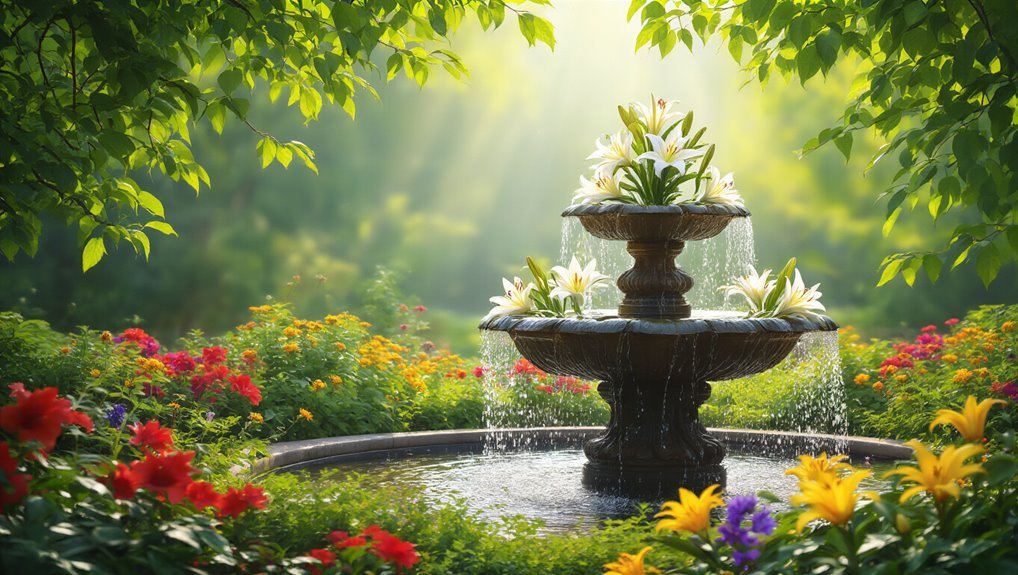
When you think about garden design, a focal point can transform an ordinary space into something extraordinary. It draws the eye, guiding your visitors to explore the area with curiosity.
A well-placed focal point creates balance and harmony, making your garden feel more inviting. Decorative birdhouses for gardens are a creative way to add charm and interest while also providing a functional home for birds. Whether it’s a stunning sculpture, a vibrant flower bed, or a serene water feature, the focal point anchors your design and adds character.
You can use height, color, or texture to emphasize this element, ensuring it stands out without overwhelming the surrounding space. By thoughtfully integrating a focal point, you’ll enhance the overall aesthetic and create a memorable experience for anyone who steps into your garden. Garden statues are a popular choice for creating beautiful focal points, seamlessly blending art and nature within your outdoor space.
Types of Focal Points in Garden Design
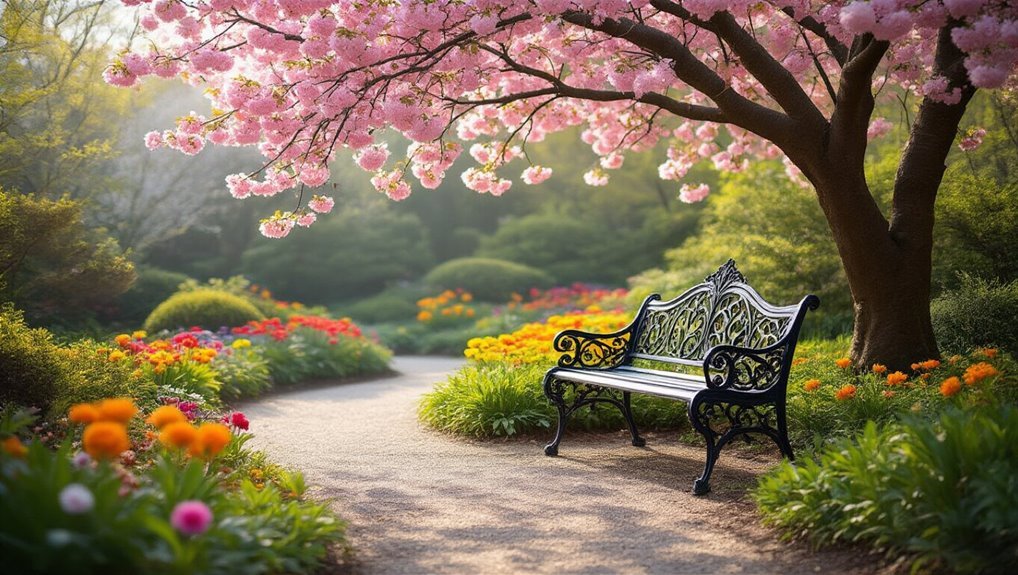
Focal points in garden design come in various forms, each adding its unique charm and character to the space. You might choose a stunning sculpture that draws the eye, or perhaps a vibrant flower arrangement that bursts with color.
A water feature, like a fountain or pond, can create a serene atmosphere while serving as a visual centerpiece. Architectural elements, such as a trellis or gazebo, provide structure and interest. Incorporating beautiful trellises can not only support climbing plants but also make your garden feel more cohesive and professionally designed.
You can also use trees or large shrubs to frame views and create a natural focal point. Even a striking bench or a unique pathway can guide visitors’ attention and enhance the overall appeal of your garden.
Selecting the right focal point is essential for effective garden design. One of the most versatile options is the use of garden arches, which not only create beautiful entryways but also serve as eye-catching focal points in any garden space.
The Role of Focal Points in Creating Visual Interest
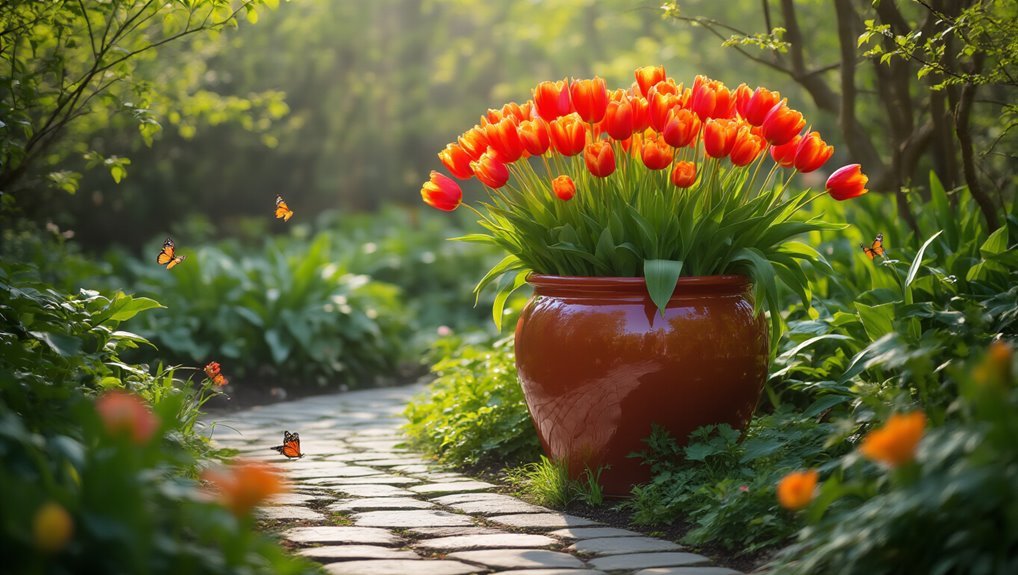
A well-placed focal point can transform your garden into a visually captivating space. It draws your eye and creates a sense of order, guiding visitors through the landscape.
By introducing elements like sculptures, water features, or vibrant flower beds, you inject life into your garden design. These focal points break the monotony of greenery, offering a striking contrast that enhances visual interest. Adding garden stakes is another effective way to introduce height, color, and whimsy to your outdoor space.
As you strategically position a focal point, consider sightlines and the overall flow of the garden. It can serve as a conversation starter, inviting exploration and appreciation.
Ultimately, a strong focal point not only elevates aesthetics but also provides a sense of purpose, making your garden feel cohesive and thoughtfully designed. Incorporating Decorative Plant Stakes is an easy way to add both structure and personality as a focal point in your garden.
How to Choose the Right Focal Point for Your Garden
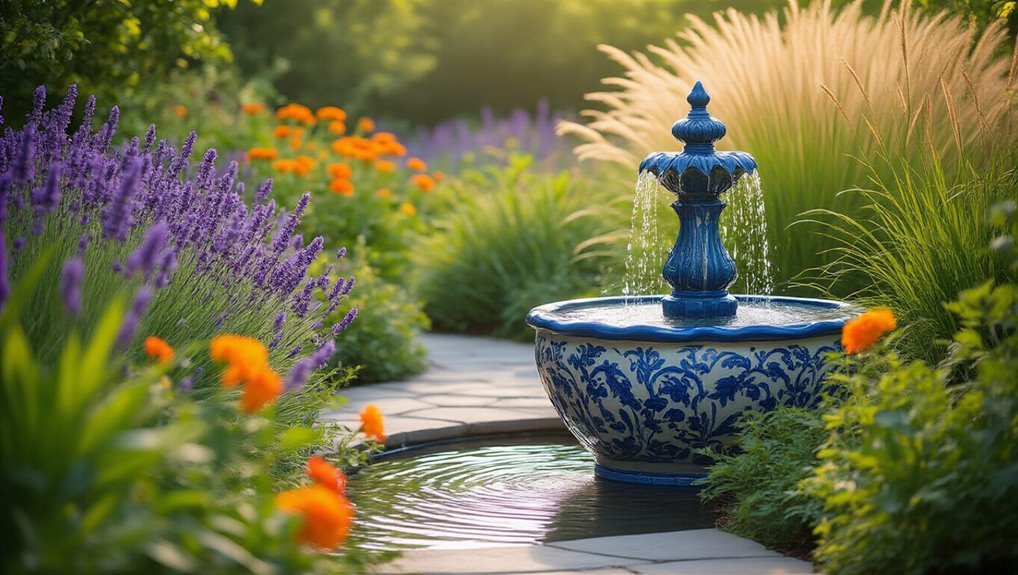
Choosing the right focal point for your garden can significantly enhance its overall appeal.
Start by considering the style of your garden—whether it’s modern, cottage, or tropical. Think about elements that resonate with you, like sculptures, water features, or a striking tree. To make garden maintenance and design easier, consider using garden carts to transport tools and plants efficiently.
Make sure the focal point contrasts with the surrounding plants and structures to draw attention. Size matters too; a large feature works well in spacious gardens, while smaller ones suit intimate spaces.
Don’t forget about color; choose something that complements your palette. Finally, consider how your focal point will look across different seasons to maintain interest year-round.
For a functional and stylish option, incorporating outdoor garden benches can serve as both a visual anchor and a welcoming spot to relax in your garden.
Positioning Your Focal Point for Maximum Impact
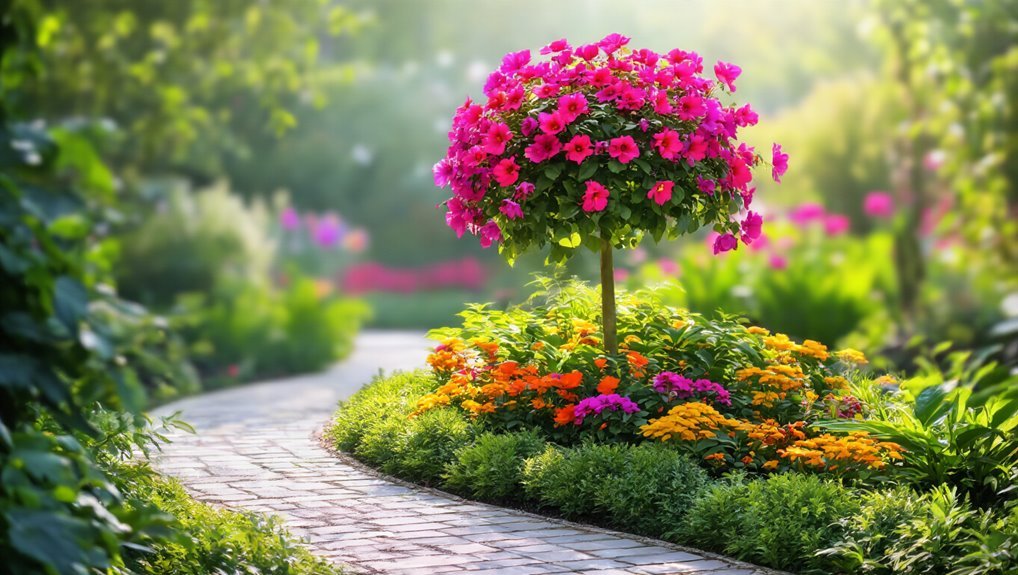
To create maximum impact with your chosen focal point, it’s essential to consider its placement within your garden’s layout. Position it where it draws the eye, such as at the end of a pathway or near a seating area. Ensure your focal point contrasts with surrounding plants and structures, making it stand out.
Height also matters; taller elements should be placed behind shorter ones to create depth. Pay attention to sightlines—your focal point should be visible from various angles to maximize its effect.
Lastly, consider the time of day and seasonal changes; a well-placed focal point can transform as lighting shifts or blooms change, keeping your garden dynamic and engaging throughout the year.
Integrating Focal Points With Garden Elements
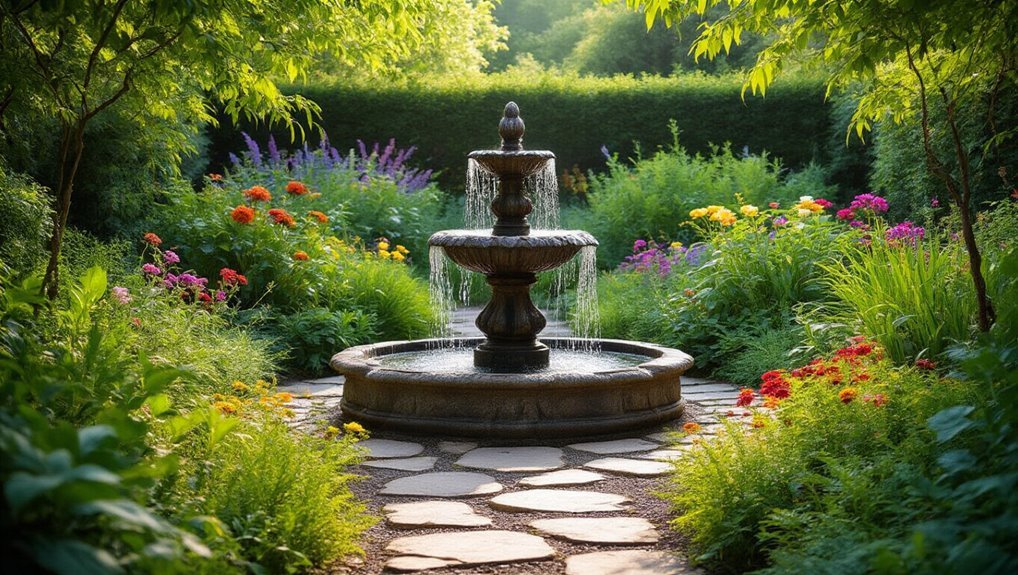
Once you’ve positioned your focal point effectively, the next step is integrating it with other garden elements for a cohesive look.
Consider the surrounding plants, pathways, and structures. Use complementary colors and textures that enhance, rather than compete with, your focal point. For instance, if your focal point is a vibrant sculpture, choose plants with softer hues nearby.
Incorporate varied heights to create visual interest—like taller plants framing a low bench or seat.
Don’t forget about lighting; strategic placement can highlight your focal point at night. By ensuring harmony among elements, you’ll draw the eye naturally, making your garden feel intentional and well-designed.
A well-integrated focal point elevates your entire space, inviting exploration and appreciation.
Seasonal Considerations for Focal Points
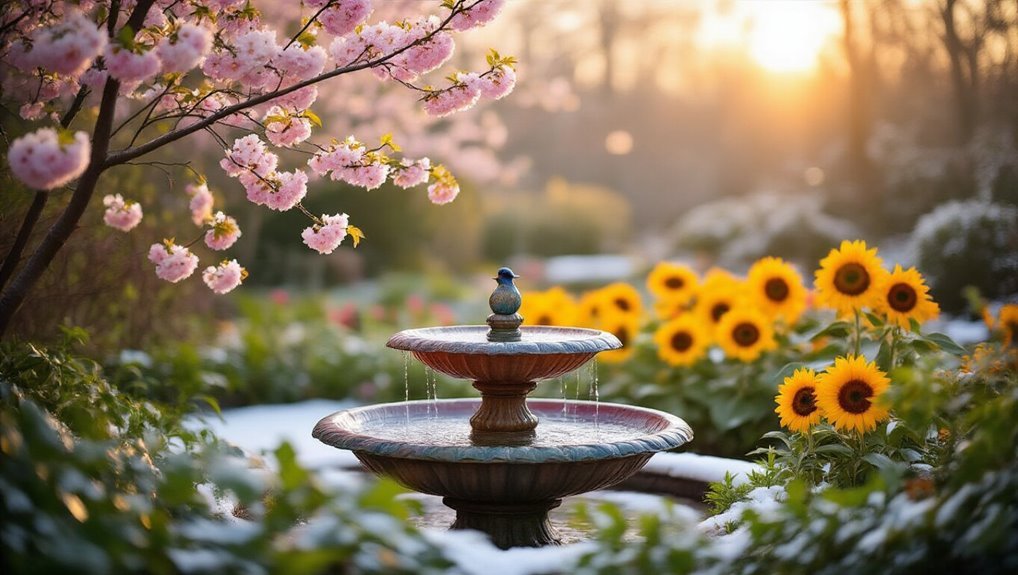
As seasons change, so should your approach to focal points in the garden. Each season offers unique opportunities to highlight different elements. In spring, vibrant blooms can draw attention, while summer’s lush greenery creates a serene backdrop.
Consider incorporating seasonal plants that thrive during each period, ensuring your focal point remains visually striking.
In autumn, warm colors can enhance your garden’s appeal, and structural elements like trees or sculptures can stand out against falling leaves.
Winter presents a chance to focus on evergreen plants or decorative features that withstand the cold.
Examples of Successful Focal Points in Gardens
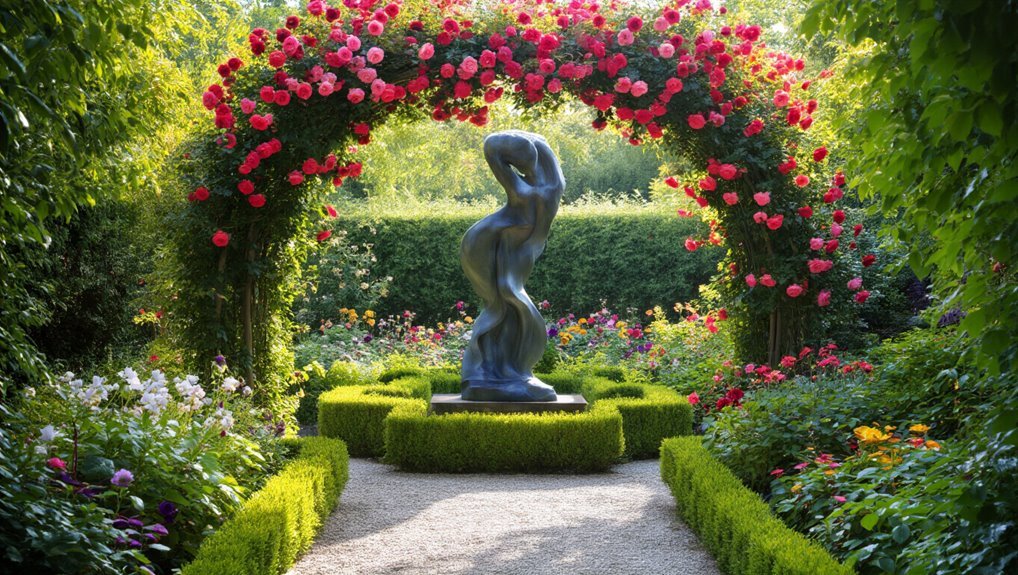
Whether you’re designing a new garden or refreshing an existing one, successful focal points can transform your outdoor space.
Consider a stunning water feature, like a pond or fountain, that draws the eye and adds tranquility. A vibrant sculpture can also serve as an artistic centerpiece, creating conversation and intrigue.
If you prefer plants, a striking tree or a cluster of colorful flowering perennials can anchor your garden design. You might even choose a unique garden bench or trellis covered in climbing vines, inviting relaxation and exploration.
Frequently Asked Questions
How Do I Maintain My Garden’s Focal Point Throughout the Seasons?
To maintain your garden’s focal point throughout the seasons, regularly assess plant health, swap seasonal flowers, and adjust lighting. Keep the area tidy, ensuring your focal point always stands out, regardless of seasonal changes.
Can I Have Multiple Focal Points in One Garden?
Yes, you can absolutely have multiple focal points in one garden! Just ensure they complement each other, creating a harmonious balance. Use varying heights, colors, and textures to guide the eye and enhance visual interest.
What Materials Work Best for Creating a Focal Point?
You’ll want to use materials that stand out and complement your garden’s style. Stone, metal, wood, or vibrant plants work well to create a focal point. Choose textures and colors that draw the eye effectively.
How Can I Incorporate Art as a Focal Point in My Garden?
Incorporating art as a focal point can increase your garden’s appeal by up to 30%. Choose sculptures, vibrant murals, or unique installations to draw the eye, creating a captivating atmosphere that reflects your style.
What Are Common Mistakes to Avoid When Designing a Focal Point?
When designing a focal point, avoid cluttering the space with too many elements, neglecting scale, or choosing low-quality materials. Instead, focus on balance, harmony, and ensuring your focal point complements the overall garden design.
Conclusion
In the end, you might think you need to fill your garden with countless flowers and decorations to impress. Ironically, it’s often that one well-placed focal point that steals the show. By carefully selecting and positioning this standout feature, you can create a captivating space that feels effortlessly sophisticated. So, while everyone else is busy overcrowding their gardens, you’ll have the secret to a beautifully balanced design—one that draws the eye without overwhelming it.
